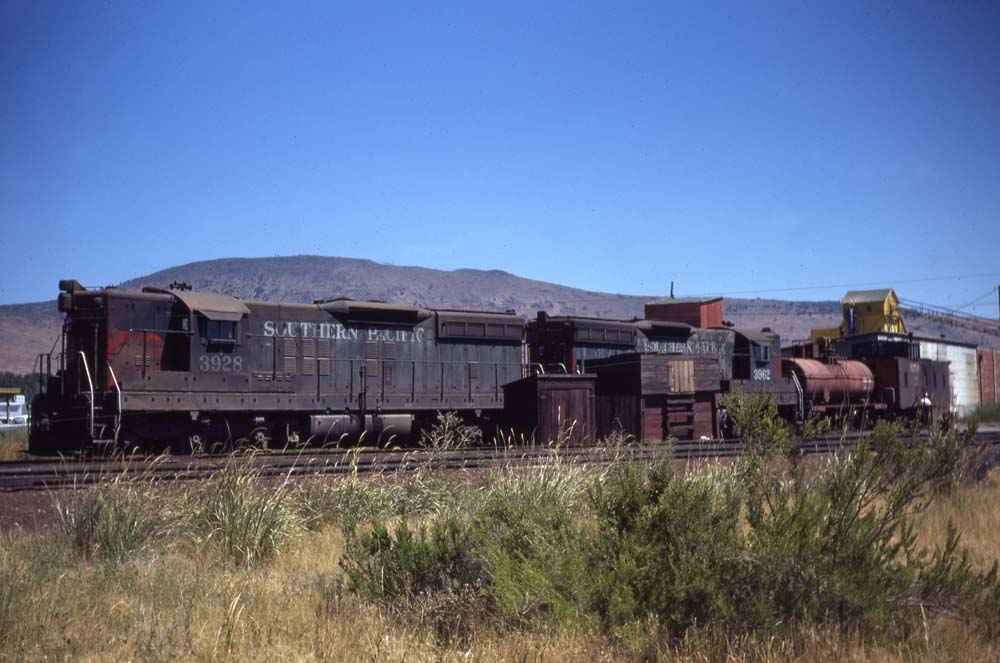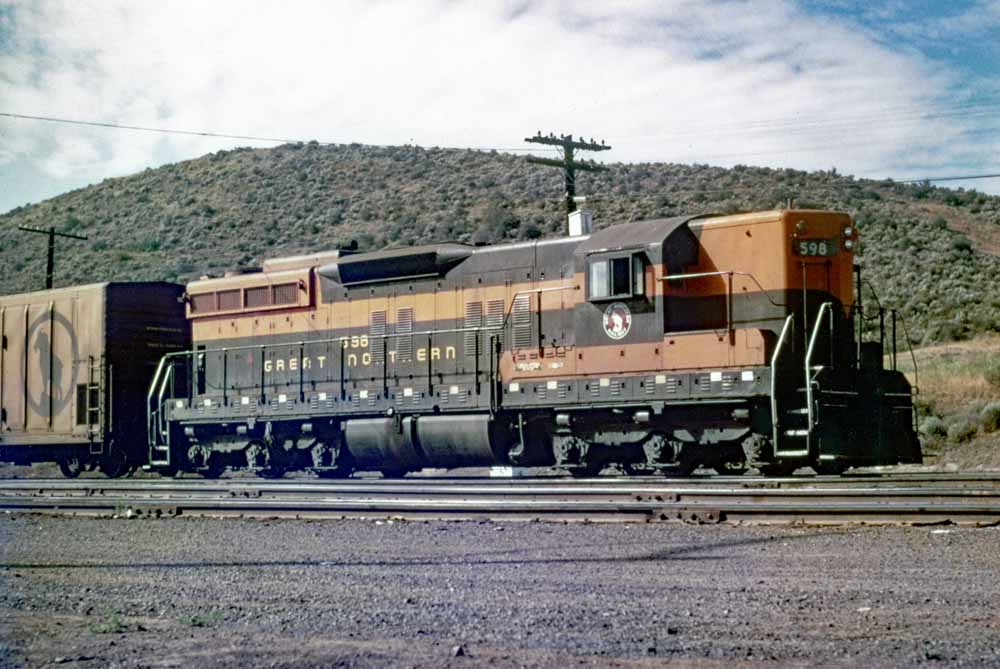|
Oregon California & Eastern Railroad History Page 2- SP and GN Take Over, 1925-1975 |
|
|
 |
|
Two SP SD-9's, a tank car, and a caboose at rest between runs in the OC&E Klamath Falls yard. Jerry Lamper photo, used with permission.
|
|
On 26 March 1925 the OC&E filed an application with the Interstate Commerce Commission to build two
lines out of Sprague River, one extending 65 north to Silver Lake plus a 15-mile branchline northwesterly
along the Williamson River from a connection with this line at a point 20 miles north of Sprague River,
and the other extending 65 miles east to Lakeview. It was at this point that outside influences finally caught up with Strahorn and the OC&E. Both the Great Northern and Southern Pacific railroads had their eye on the railroad. The SP was looking to build a shortcut for eastbound lumber traffic to run from Klamath Falls southeast to a connection with their transcontinental mainline in western Nevada, and combining the OC&E with the Nevada-California-Oregon railroad from Lakeview to Wendel, CA, then over the Fernley & Lassen railroad from Wendel, CA to Fernley, NV would complete this shortcut with a minimum of new construction. The SP was also not happy with the prospect of sharing traffic from the Klamath Basin with anyone else, and acquiring the OC&E would prevent it from ever making a connection with any other railroads it was trying to reach. However, the GN was seeking to build south from Bend to Klamath Falls at this point, and their plan was to build this line through Silver Lake. Almost their entire proposed line south from Silver Lake would closely parallel the OC&E projected and completed lines. The news soon broke in the Klamath Falls newspapers that Strahorn was negotiating to sell the OC&E to the SP. The headlines of the newspapers screamed about how Strahorn has duped the city and its citizens, but the public outcry did not stop Strahorn from agreeing to sell his stock in the OC&E to the Southern Pacific for $495,000. The citizens of Klamath Falls then went to court seeking to get the money advanced to Strahorn back, most notably the $300,000 in construction money and the property donated for the terminal that was never built. Other issues involving the railroad were also contested, such as the right of the railroad to cross city streets. ICC approval for the construction of the various proposed extensions and for the SP to acquire control of the OC&E both came in May 1926, but in its rulings the agency indicated strong support for joint GP-GN control of the OC&E to preserve competition. The Southern Pacific took full control of the OC&E on 22 July 1927, and then SP and GN signed a contract to sell a one-half interest in the company to the GN on 18 November 1927, with the transaction finalized on 23 March 1928. The only one of the approved extension ever constructed was a line that ran 26.4 miles from Sprague River eastward to Bly, and that was accomplished by order of the ICC. Construction on the extension began on 3 July 1927, but the job was not completed until the end of 1928, and even then weather prevented regular operations from commencing until 30 April 1929. Only two branches were ever built by the OC&E, with both of them stretching less than two miles off the mainline. The first ran 1.84 miles from Swan Lake Junction to Swan Lake, and the second was intended to run from 6.70 miles Dairy to Bonanza, although only 1.57 miles of the proposed line were completed. The Swan Lake branch was abandoned on 22 September 1929, and the Bonanza branch was cut back several times throughout the history of the railroad, with at least a stub remaining at the end of operations. The OC&E maintained independent operations until 1933, when the two parents took over operations directly. For the first few years the parent roads handled operations in one year intervals, later changed to five year intervals. The OC&E continued to run with its own crews until attrition thinned the ranks out, after which operations were handled by employees brought in by whichever parent that was handling operations at the time. All motive power and equipment used on the line would also be provided by the operating road. Dominant traffic on the OC&E was always log traffic bound for sawmills in Klamath Falls, and no less than six different lumber companies built logging railroads off of the OC&E at various points through the years, and a great many more logging outfits loaded logs onto railcars on sidings along the route. The OC&E also handled whatever other traffic that was offered to it, including agricultural traffic in the form of grain and potatoes, livestock and inbound petroleum products. The OC&E also provided switching services for a number of industries in the immediate vicinity of Klamath Falls. |
 |
|
Great Northern SD-9 #598, one of two such units the road bought with dynamic brakes specifically for use on the OC&E,
switching in Klamath Falls. Unknown photographer, Jeff Moore collection.
|
|
|
|
|